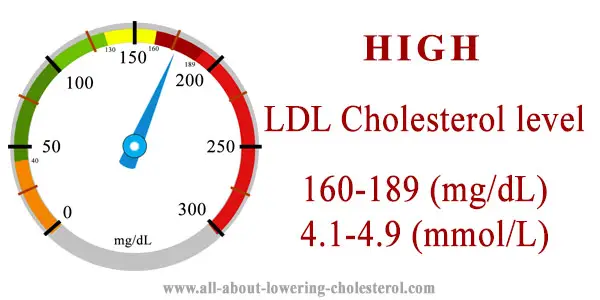
LDL cholesterol level 160-189 mg/dl is considered as high. This range include levels of LDL cholesterol of 161, 162, 163, 164, 165, 166, 167, 168, 169, 170, 171, 172, 173 174, 175, 176, 177 ,178, 179, 180, 181, 182, 183, 184, 185, 186, 187, 188.
The higher the LDL cholesterol levels, the higher the risk of developing such health issues. The risk factors of such LDL levels include gender, age, heredity, diet, physical activity, and body weight.
What does having LDL cholesterol level 160-189 mg/dl mean?
LDL cholesterol is a substance produced by the liver and distributed throughout the body via bloodstream in order to fulfill the body’s need for cholesterol.
Cholesterol travels in the bloodstream bided with other proteins, such as LDL, HLD etc. LDL cholesterol level 160-189 mg/dl is considered as high cholesterol level.
Cholesterol it is a substance of primary importance for the cells, and its presence is necessary for the well-functioning of the membranes of every cell, and also for the production of various hormones such as steroid hormones, sexual hormones etc.
But, if the levels of LDL cholesterol exceed the normal values, there can be various health issues happening.
LDL cholesterol level 160-189 mg/dl – What are the levels of risk for Cardiovascular disease?
Having LDL cholesterol level 160-189 mg/dl is associated with an increased level of developing cardiovascular problems, which can result to be even life-threatening.
This risk is multiplied if having other cardiovascular disease risk factors such as hypertension, diabetes, old age, heredity, smoking etc. The higher the LDL cholesterol level, the greater the risk.
LDL cholesterol forms a fatty substance called plaque which can build up in the walls of the arteries of the heart.
The smaller plaques tend to stay small and, if not ruptured, often cause no health complications, but bigger plaques tend to grow over time and form a fibrous cap with calcium deposits.
The result of this process is atherosclerosis, or else called the “hardening of the arteries”. The heart can be endangered by this process in two ways:
1. The calcified and atherosclerotic arteries are inelastic, and become narrower over time, causing less and less sufficient oxygen-rich blood from reaching the heart. This causes chest pain, and in severe cases heart attack and even death.
2. Smaller plaques may rupture and form a blood clot on their surface. These clots block the arteries and are important causes of heart attacks.
LDL cholesterol level 160-189 mg/dl – The risk for any other health problems?
Levels of cholesterol 160-189 mg/dl are associated with an increased risk of developing not only cardiovascular disease but also other health problems.
1. Peripheral heart disease – It is caused by the buildup of the plaques in the arteries of the feet, legs, arms and hands. It happens mostly on the arteries of the legs.
2. Stroke – It is caused by the buildup of plaques in the arteries of the brain. The most important factor in the protection against strokes is the level of HDL cholesterol. The higher the HDL levels the better.
LDL cholesterol level 160-189 mg/dl – Controllable and Uncontrollable Risk Factors
There are some risk factors causing levels of LDL cholesterol 160-189 mg/dl such as following:
I. Controllable Risk factors – you can make some changes that can reverse LDL levels:
1. Diet – Trans fats, saturated fats, sugar, and cholesterol in the foods you eat can increase the levels of LDL cholesterol.
2. Weight – Being overweight increases your LDL cholesterol level and decreases your HDL cholesterol level
3. Physical activity – A sedentary life without physical can increase your LDL cholesterol.
II. Uncontrollable risk factors – unfortunately, cannot change them
1. Gender – After menopause, a woman’s LDL cholesterol increases.
2. Age – The risk of having increased LDL cholesterol levels increases with old age ( over 45 years old for men and over 55 years old for women)
3. Family history – The risk of having increased levels of LDL cholesterol increases if having a first-line family member (parents or siblings) with high levels of LDL cholesterol.
